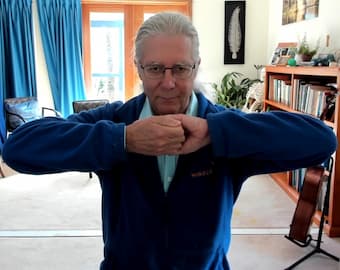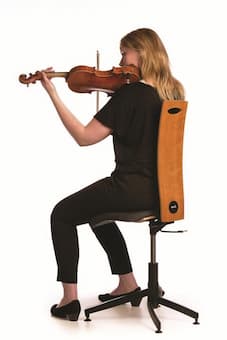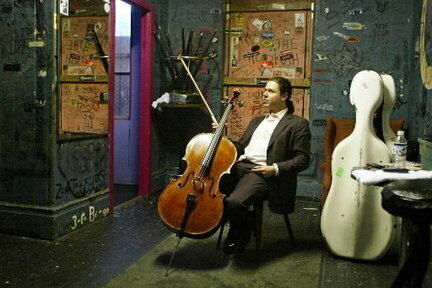
Backstage Trunks
“Why don’t you get a new publicity photo to match your new hair color?” a man said to me immediately after I performed the Elgar Cello Concerto in a Northern Minnesota town. I thought I’d played it pretty well… and yes… A few gray hairs had been sprouting (from audience members like him.) The insults can fly even backstage at concerts and rehearsals—not as genteel as we look, we classical musicians, and although we may appear formal and the atmosphere may be rarified backstage, especially if we have a famous guest conductor or soloist in town that week, we too indulge in food, gossip, jokes and card-playing in addition to practicing.
Many musicians are sports enthusiasts. We had an ancient television in our musician’s lounge, which was always set to the big games of the weekend. The score was conveyed via hand signals from the wings to those who were onstage. Backstage our cases or lockers become our “home away from home” the contents of which contain everything from tea, snacks, and chocolate, to changes of clothes, bicycles helmets (for those who rode to work), books, headphones (to listen to upcoming works for following weeks), and our iPads or iPhones to keep up to date on emails and Facebook. Most important are extra supplies like strings, rosin (to make the bowhair stick to the string, extra reeds, (for woodwind players), extra mouthpieces, mutes and earplugs.
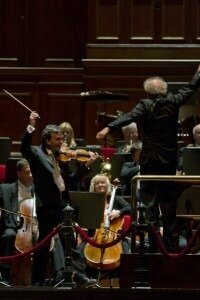
Gil Shaham and Janet in Amsterdam
Onstage a great deal of concentration and hard work occurs. There is no getting out of your seat, no lapses of concentration. We strive to produce exactly what the conductor wants, and to blend in with one’s section and the rest of the orchestra. But some subtle gestures and mouthing of words across the stage do occur. We are very good at lip-reading, eye rolling, stifling giggles, (especially when there is a boring conductor), and cough and sneeze suppression.
Usually the player on the inside of the stand writes instructions from the conductor in pencil on the sheet music and turns the pages. If fingerings are placed in the part, one player will put theirs above the line of music and the other under the line of music as each player has idiosyncratic and unique fingerings. All the bow markings are decided by the concertmaster and then matched by each string section leader ahead of time. The librarians mark them into the parts. Frequently a conductor will decide to change something and then the musicians scramble to write the new phrasing or dynamic into the parts. Everything is done quickly, quietly and efficiently. There is usually too little rehearsal time. Some conductors are talkers and when they’ve squandered precious rehearsal time we end up sight-reading the concert!
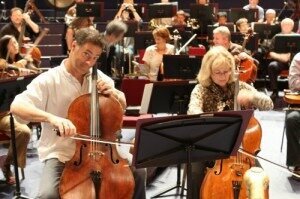
Tony Ross and Janet Proms 2010
Beethoven: Symphony No. 9 (Minnesota Orchestra, Osmo Vänskä) – I. Allegro ma non troppo, un poco maestoso
I remember a particularly grueling recording session of Beethoven’s Ninth Symphony. We had two four-hour sessions back to back for most of the week. Not only is this a very difficult work, it is long. With the massive number of performers backstage, it was tough to get a snack, take a breath or find respite from the stress. A microphone was suspended above each stand of upper strings and winds, and placed lower down for the cello section—so close that we worried about belts or earrings rattling, stomachs grumbling, stumbling on the wide legs of the microphone stands and shoes squeaking.
Osmo Vänskä, our music director, removed his shoes and set them next to his podium conducting in his stocking feet. At one of the breaks several musicians piled their shoes on top of his. It was a moment of hilarity in an otherwise stressful day.
Haydn: Violin Concerto in C Major (Cho Liang Lin, Minnesota Orchestra, Sir Neville Marriner) – I. Allegro moderato
But the humor stopped there. During the editing process, it was discovered that not one of the several versions of an exposed violin passage was perfect. Vänskä and the producers resorted to listening to the takes stand by stand so as to discern which musicians played the passage out of tune! The producer eliminated the offending two violin stands from the mix. Another time, during a recording of the Haydn Violin Concerto in C with Cho Liang Lin and conductor Sir Neville Marriner, there were microphones placed at the head of each string section. Marriner wanted to get a more “distant” sound. The first stands of all the strings were asked to leave for the slow movement.
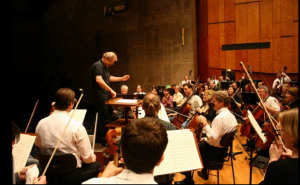
Osmo in rehearsal
Conductors are known for their sarcasm in rehearsal, “If you think I am behind,
play s-l-o-w-e-r.” “Some person thinks my tempo is wrong,” one Maestros said. “I am here in case you want to look up to use my services,” said another. A favorite comment was, “This side is too slow; that side is too fast—average is good.”
After the concert, one of my colleagues, Sam Bergman— a violist and a jokester at that— once said, “if you have occasion to speak to one of the musicians, do not ask us what we think of the conductor. We are unlikely to tell you the truth, and the question merely forces us to construct an elaborate half-lie with a pained smile on our face. Besides, we tend to hate almost all conductors, regardless of their individual merits, and we are therefore not reliable sources of accurate information on the subject. If you liked him, that’s all that matters.”
The conductor sometimes has to be a jack-of-all-trades—a teacher, a psychologist, a poet and muse, a commander, an articulate advocate, and above all we hope, respected by the musicians, management and audience members. According to Finnish conductor Esa-Pekka Salonen the principal conductor of the Philharmonia Orchestra in London, it’s “about being able to focus the thoughts and ideas of a large group of people and enable them to achieve the desired artistic result,” and to allow us to play with passion, to be free to interpret the music, try ideas in rehearsal and perform with flair in the concert.

